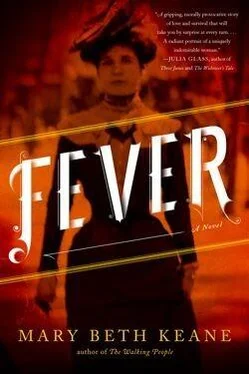Only seconds later, Mary heard Frank shout from the first floor and then the rush of hard-soled shoes to the stairs. Mrs. Bowen was out shopping. Mr. Bowen was at his office downtown. It was supposed to be an ordinary Friday, a better-than-ordinary Friday, since Mary would have to cook only for the staff, and for them it would be easy: no serving, dinner together around the table in the kitchen. Clutching the doorknob for help, Mary peeked into the empty hall. She stepped out and stayed close to the wall until she got to the narrow back stairs. Down she went, silent as a cat, until she reached the back door of the house. Outside, the snow was falling faster. Feeling nothing but her own heart beating in her chest, she ran along the footpath that led over to the fence and unlatched the door that led from the Bowens’ yard to the Alisons’. When she looked back to see if anyone was watching her, she noticed her footprints in the snow. She hurried back to cover her tracks, and then, walking backward, leaned over to brush away the footprints with her hands.
The door to the Alison kitchen was locked — the servants mostly having been let go while the family was in Europe. At the edge of the yard was a supply shed. It was a small structure, little more than a low closet with a roof, but the door was unlatched, and when she stepped inside there was just enough room among the pruning sheers, the bags of sand, and the drums of kerosene for one person to crouch and wait.
She didn’t feel the cold at first, and considered herself well protected in the little room. But after a while she could feel the wind where it slipped in between the spaces in the planks, and her knees ached from crouching. She shifted a few bulky canisters of oil and made room to sit on the packed dirt ground. She wished she could hear what was happening on the Bowen side of the fence. Would Frank or Bette remember to get her once the police officers gave up and moved on? There was nothing to do but wait.
• • •
Later, Mr. O’Neill would ask her what she made of Dr. Soper’s pursuit, why she wasn’t more surprised to be hounded the way she was. “I was surprised!” Mary said. “I was shocked!”
“But you didn’t behave like a person who was surprised and shocked,” he insisted. “You behaved like a person who expected to be pursued. Do you understand the difference? You reacted too quickly. How did you know when you looked out the window and saw the police that it was you they’d come for? That’s the problem they have with you. That’s part of the reason they don’t believe you when you claim to have had no idea you were spreading disease.”
“I’m not spreading disease.”
“You see? Even there. You sound like a person who’s been defending herself for years, long before anyone accused you.”
“Meaning?”
“Meaning, there must have been a moment when it crossed your mind that all of this was true. The question they have is whether it occurred to you after their accusations, or before.”
“I don’t understand.”
“You do understand. Think.”
• • •
Alone in the silent supply shed, Mary tried to think about only nice things, normal things, what she needed from the grocer’s, what she’d cook for Alfred next time she went home, but instead she kept thinking of the officers searching for her. She thought of the people who’d been sick in Oyster Bay, and how she’d known they would make it if she worked to keep the fever down. It was a fast-moving fever, that one. Doctors talked about fevers as if they were all the same, but there were fevers and there were fevers, and Mary could distinguish one from another with the touch of her hand. One day everyone was playing tennis, riding horses, and the next they complained of being dizzy. They stopped eating. The gardener vomited very near the water cistern. Mrs. Warren fainted on the porch. Mary had seen it enough times to know that Mrs. Warren and the other adults who caught it would survive. They were in pain, yes, and called out nonsense, and tossed and turned and sweated through all their sheets and vomited bile. Still, Mary had seen Typhoid Fever at its worst, she’d seen death come a few times, and in each of those times the fight was mismatched from the beginning. The Warren girl was the only real worry, the poor child, only eight years old. She didn’t have the fight in her that the others had. That was the dangerous moment, when the patients didn’t have the fight, when they just slept and stared and preferred to keep their eyes closed. When the moaning stopped. When the nonsense stopped. And that girl was so quiet to start with.
Mary threw her whole body into beating death away from the girl. She filled the tub to the brim and reached her own hand in the water to show her what it was like to splash inside the house, over the wood of the floor, a thing that would never be allowed if everyone were healthy, and the girl seemed interested in that. Mary told her about her passage to America, and what Ireland was like. The girl would never go to Ireland. England, maybe, Mary informed her. Paris. But not Ireland. Not many went to Ireland, they just went away from it. But it was her home just like New York City was the girl’s home, and what was it the poet said? Every savage loves his native shore. And that’s when she knew the girl would survive. She leveled her eyes on Mary, and there was life behind them. “Are you a savage, Mary?”
“I am. Like we all are.”
And the girl considered it. “I’m not,” she said.
“No?”
“Absolutely not.”
So the Warren girl survived, and everyone else in the Warren house survived and they still wanted her.
That’s part of what was so worrying about the Bowen girl, that they wouldn’t let her anywhere near. If she could only just see her, but even now, with the police searching the house for her, Mary was sure the girl’s nurse had not so much as stepped out into the hall to see what was going on. When they knocked on the door to pass in ice and fresh linens, the nurse blocked their view of the girl’s bed with her body, accepted what was given, and shut the door again.
Then she thought of the boy, the Kirkenbauer baby, only two years old. Just two. Barely two. Crouched in the Alisons’ storage shed, her hands stinging with the cold, she tried everything to keep him out. She hummed songs. She recited poetry. After returning home from the Kirkenbauers’ back in 1899, she didn’t even look for another situation for a whole month. She made sandwiches and sold them to the men who worked at the lumberyard on Twenty-First Street. When they handed over their coins and she handed over the sandwiches, they were perfect strangers to her, and she decided that was what she wanted: to cook for people but not to know them at all. She didn’t want to see people when they woke up in the morning. She didn’t want their children hugging her legs and learning her name.
Mary waited in the shed for what felt like hours. She was hungry. She was stiff and cold and worried about getting sick. Who would cook for the Bowens if she got sick? She unwound a long piece of burlap from around the garden equipment stored on a shelf behind her and wrapped it around her shoulders. She hugged her knees to her chest and exhaled hot breath on her fingers. At one point she thought she heard Bette calling her, so she opened the door and saw a policeman’s hat moving along the other side of the fence. She tried not to think about time, and whether she’d be there all night, whether she should risk running alongside the Alisons’ house and out to the sidewalk and away downtown. In one moment she felt sure they’d give up, go home, and never come for her again, and in another moment she knew they’d be waiting for her on Thirty-Third Street. They’d be waiting for her everywhere she went.
Читать дальше












